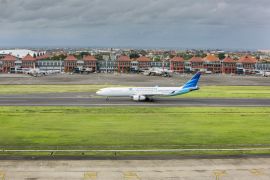... Australian tourists are ignoring warnings against visiting Indonesia, particularly Bali."Jakarta (ANTARA News) - The Indonesian plan to execute two Australian nationals on death-row convicts for a drug case has not reduced Australian tourist visits to Bali.
"This indicates that Australian tourists are ignoring warnings against visiting Indonesia, particularly Bali," tourism observer Tjok Gede Agung told Antara Bali over the weekend.
In January 2015, Bali recorded 85,059 tourist arrivals from Australia. During the past two months, Australian tourists visiting the province were the highest among other foreign tourist arrivals, reaching 156,424, up 16.74 percent from the same period last year, when their number was recorded a 133,966.
Further, Australian tourist arrivals were the highest among foreign tourists arriving from different countries.
They accounted for 24.41 percent of the total number of foreign tourists arriving in the first two months of 2015, which stood at 640,739.
The highest number of Australian tourists arriving in Bali was followed by the number of tourists coming from China, which stood at 145,747 during the same period (January and February, 2015).
The number of Japanese tourists visiting Bali has also begun to increase since the opening of regular direct flight from Japan to Denpasar.
In the January - February 2015 period, the number of Japanese turists was recorded on the third biggest list, recording 40,544 arrivals, followed by that of South Korea which stood at 28,523.
The political issues are expected to not affect the foreign tourist arrivals in Bali. Therefore Agung hoped that the government, tourism operators and the people should continue to increase the quality of their services.
"This needs to be done because Bali still constitutes the main destination of foreign tourists in Indonesia," he said.
In the meantime, the regional government of Bali province has set itself the target of attracting one million Chinese tourists in 2015, following the implementation of a visa-free visit policy for 45 countries.
"Indonesia received 560 thousand Chinese tourists last year. We hope the figure increases to one million this year," Governor of Bali Made Mangku Pastika said here on Saturday.
He added that there was a great chance for Chinese tourist arrivals in Bali to rise as they constituted the second largest number of foreign tourists that visited the resort island.
After all, Pastika remarked, he had made reciprocal visits to the two Chinese provinces of Yunnan and Hainan.
"We are ready to receive a larger number of Chinese tourists, now that we offer a visa-free visit. However, we still need to improve upon our shortcomings," the governor pointed out.
According to the Central Bureau of Statistics (BPS), the largest number of tourist arrivals in Indonesia in February 2015 was from China.
BPS Chief Suryaman said that China accounted for 18.2 percent, or 144,000, of the 786,700 arrivals of foreign visitors to the country in February.
After China was Malaysia, accounting for 12.43 percent, or 97,800 arrivals, followed by Singapore with 12.39 percent, Australia with 10.43 percent, and Japan with 5.89 percent.
"Most of the Chinese travelers were probably visiting with the intention of expanding their businesses in Indonesia," Suryamin told reporters in Jakarta on Wednesday.
The number rose before the government announced that its visa-free visit policy for 30 more countries, including China, will come into effect in April, he noted.
The number of tourists from China is expected to increase with this facility for tourists from 30 more countries, he affirmed.
The government added these 30 countries to the list of 15 other countries that already enjoyed the visa-free visit policy.
The policy is expected to double the number of arrivals of foreign tourists to 20 million by the end of the present governments term in 2019.
Furthermore, a surge in tourist arrivals in February was recorded in a number of entrance gates. The highest increases were recorded at Sam Ratulangi Airport of North Sulawesi, up by 212.70 percent, at Jakartas Tanjung Priok Seaport, up by 43.46 percent, and at Tanjung Pinang Seaport of Riau Islands, up by 30.84 percent.
Declines were recorded in 10 other entrance gates, such as the airports of Sepinggan of East Kalimantan, down by 35.08 percent, and in Minangkabau of West Sumatra, down by 0.45 percent.
(Uu.A014)
Editor: Priyambodo RH
Copyright © ANTARA 2015











